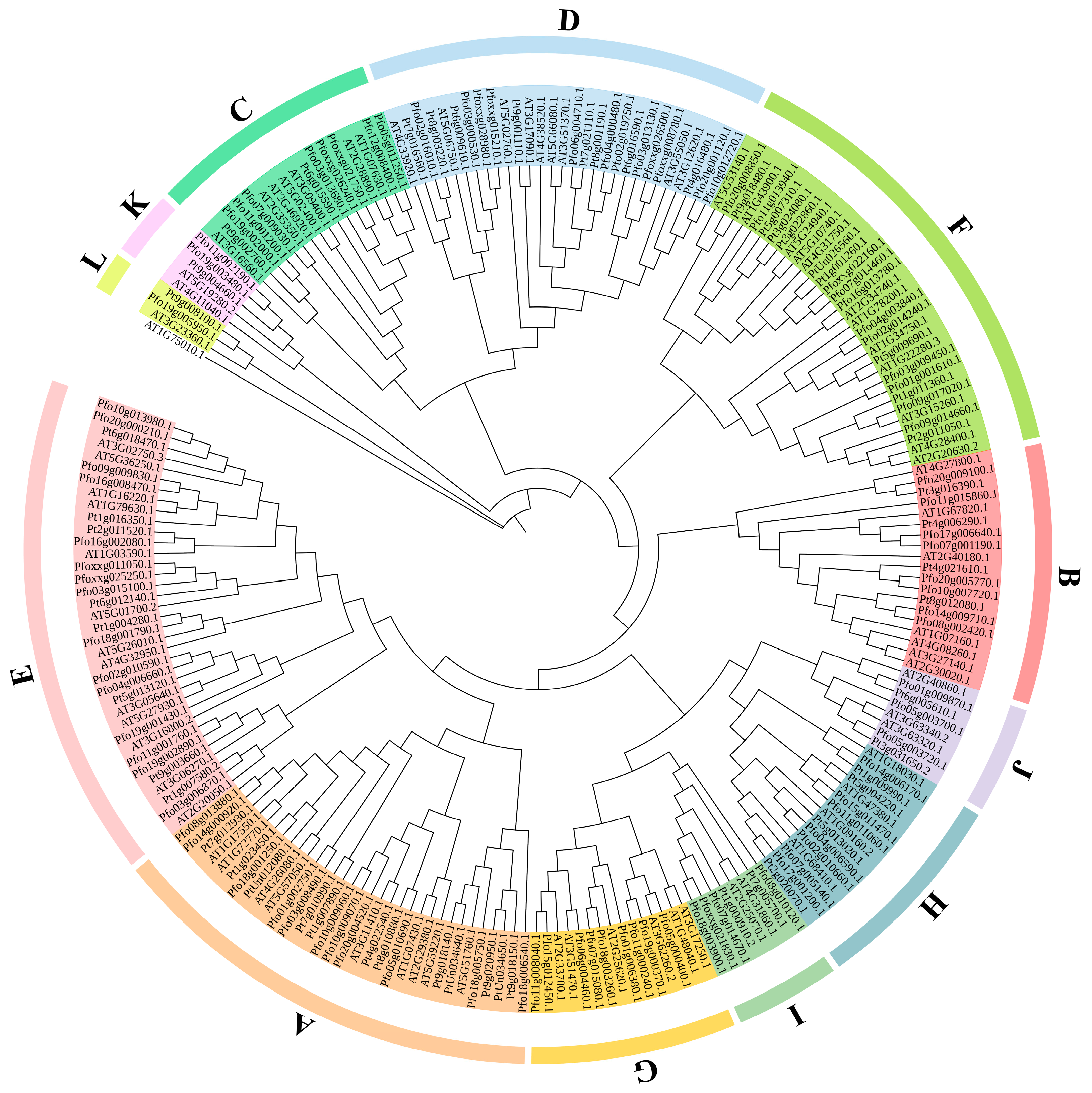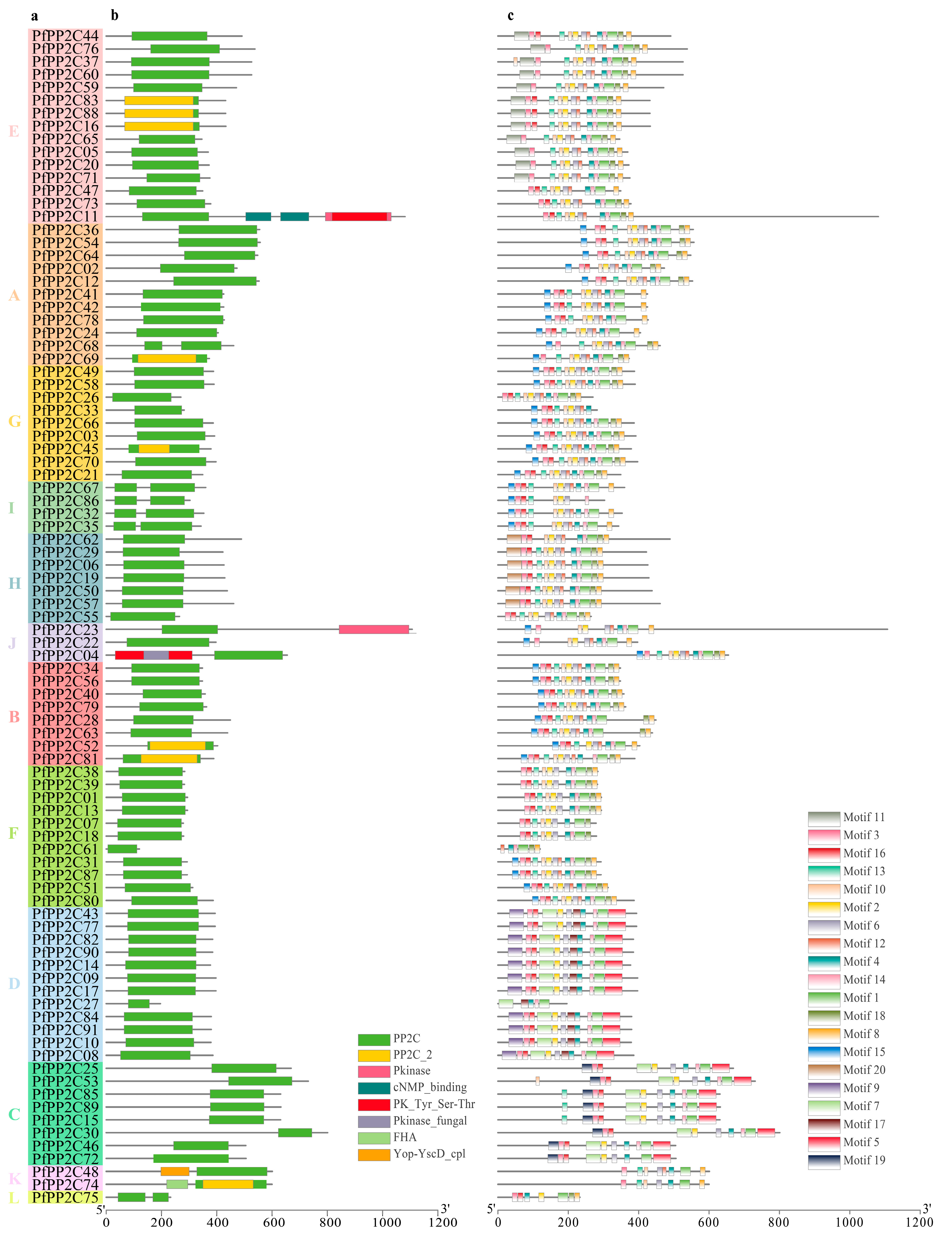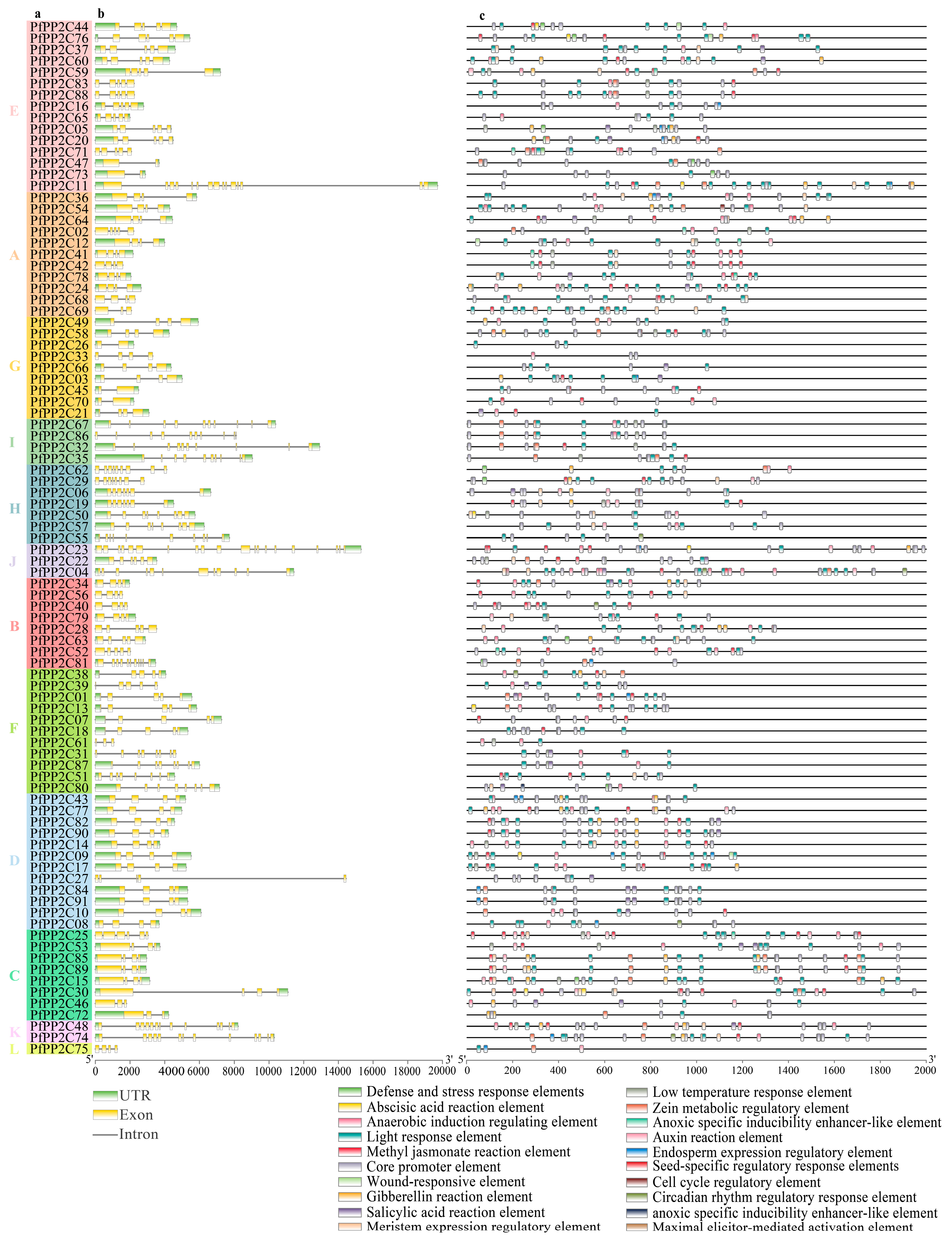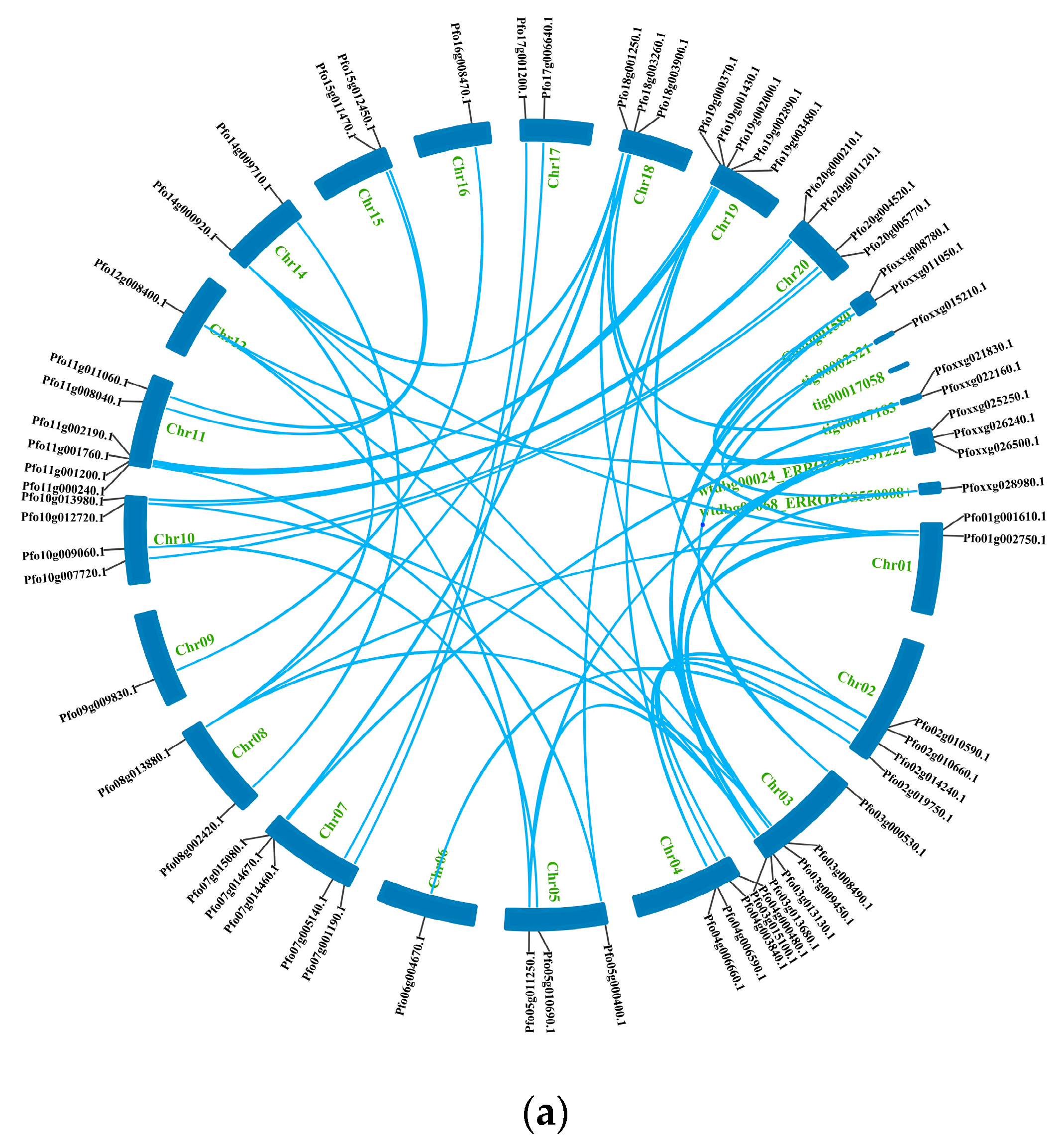Genome-Wide Identification and Expression Analyses of the PP2C Gene Family in Paulownia fortunei
Abstract
1. Introduction
2. Materials and Methods
2.1. Identification, Physicochemical Properties, and Prediction of Subcellular Localization of PP2C Family Members in P. fortunei
2.2. Chromosomal Localization and Phylogenetic Analysis of PP2C Genes in P. fortunei
2.3. Conserved Structural Domains, Conserved Motifs, and Gene Structure Analysis of PP2C Family Members in P. fortunei
2.4. Analysis of Promoter Cis-Acting Elements and Covariance in Members of the PP2C Family in P. fortunei
2.5. Expression Analysis of PP2C Genes in P. fortunei
3. Results
3.1. Identification and Physicochemical Properties of the PP2C Family in P. fortunei
3.2. Prediction of the Subcellular Localization of PP2C Family Members of P. fortunei
3.3. Chromosomal Localization of PP2C Genes in P. fortunei
3.4. Phylogenetic Analysis of Members of the PP2C Family in P. fortunei
3.5. Analysis of Conserved Structural Domains and Conserved Motifs of PP2C Family Members of P. fortunei
3.6. Structure of PP2C Genes in P. fortunei
3.7. Analysis of Cis-Acting Elements in Promoters of PP2C Genes in P. fortunei
3.8. Covariance Analysis of Members of the PP2C Family of P. fortunei
3.9. Expression Analysis of PP2C Family Members in P. fortunei
4. Discussion
5. Conclusions
Author Contributions
Funding
Data Availability Statement
Acknowledgments
Conflicts of Interest
References
- Hunter, T. Protein kinases and phosphatases: The Yin and Yang of protein phosphorylation and signaling. Cell 1995, 80, 225–236. [Google Scholar] [CrossRef] [PubMed]
- Luan, S. Protein phosphatases and signaling cascades in higher plants. Trends Plant Sci. 1998, 3, 4–10. [Google Scholar] [CrossRef]
- Hunter, T. Protein-tyrosine phosphatases: The other side of the coin. Cell 1989, 58, 1013–1016. [Google Scholar] [CrossRef] [PubMed]
- Mumby, M.C.; Walter, G. Protein serine/threonine phosphatases: Structure, regulation, and functions in cell growth. Physiol. Rev. 1993, 73, 673–699. [Google Scholar] [CrossRef]
- Luan, S. Protein Phosphatases in Plants. Annu. Rev. Plant Biol. 2003, 54, 63–92. [Google Scholar] [CrossRef] [PubMed]
- Cohen, P. The structure and regulation of protein phosphatases. Annu. Rev. Biochem. 1989, 58, 453–508. [Google Scholar] [CrossRef]
- Schweighofer, A.; Hirt, H.; Meskiene, I. Plant PP2C phosphatases: Emerging functions in stress signaling. Trends Plant Sci. 2004, 9, 236–243. [Google Scholar] [CrossRef]
- Kerk, D.; Bulgrien, J.; Smith, D.W.; Barsam, B.; Veretnik, S.; Gribskov, M. The complement of protein phosphatase catalytic subunits encoded in the genome of Arabidopsi. Plant Physiol. 2002, 129, 908–925. [Google Scholar] [CrossRef]
- Ruan, H.H.; Xu, L.L. Progress in the structure and function of PP2C-type protein in phosphatases. J. Nanjing Agric. Univ. 2007, 30, 136–141. [Google Scholar]
- Hu, X.B.; Song, F.M.; Zheng, Z. Structure and function of protein phosphatase 2C in higher plants. Chin. J. Cell Biol. 2005, 27, 29–34. [Google Scholar]
- Fuchs, S.; Grill, E.; Meskiene, I.; Schweighofer, A. Type 2C protein phosphatases in plants. FEBS J. 2013, 280, 681–693. [Google Scholar] [CrossRef] [PubMed]
- Raghavendra, A.S.; Gonugunta, V.K.; Christmann, A.; Grill, E. ABA perception and signalling. Trends Plant Sci. 2010, 15, 395–401. [Google Scholar] [CrossRef] [PubMed]
- Chu, M.L.; Che, P.W.; Meng, S.F.; Xu, P.; Lan, W.Z. The Arabidopsis phosphatase PP2C49 negatively regulates salt tolerance through inhibition of At HKT1;1. J. Integr. Plant Biol. 2021, 63, 528–542. [Google Scholar] [CrossRef] [PubMed]
- Schweighofer, A.; Kazanaviciute, V.; Scheikl, E.; Teige, M.; Doczi, R.; Hirt, H.; Schwanninger, M.; Kant, M.; Schuurink, R.; Mauch, F.; et al. PP2C-Type phosphatase AP2C1, which negatively regu-lates MPK4 and MPK6, modulates innate immunity, jasmonic acid, and ethylene levels in Arabidopsis. Plant Cell 2007, 19, 2213–2224. [Google Scholar] [CrossRef]
- Gagne, J.M.; Clark, S.E. The Arabidopsis stem cell factor POLTERGEIST is membrane localized and phospholipid stimulated. Plant Cell 2010, 22, 729–743. [Google Scholar] [CrossRef]
- Xue, T.; Wang, D.; Zhang, S.; Ehlting, J.; Ni, F.; Jakab, S.; Zheng, C.; Zhong, Y. Genome-wide and expression analysis of protein phosphatase 2C in rice and Arabidopsis. BMC Genom. 2008, 9, 550. [Google Scholar] [CrossRef] [PubMed]
- Akiyama, M.; Sugimoto, H.; Inoue, S.I.; Takahashi, Y.; Hayashi, M.; Hayashi, Y.; Mizutani, M.; Ogawa, T.; Kinoshita, D.; Ando, E.; et al. Type 2C protein phosphatase clade D family members dephosphorylate guard cell plasma membrane H+-ATPase. Plant Physiol. 2022, 188, 2228–2240. [Google Scholar] [CrossRef] [PubMed]
- Zhang, C.; Yu, J.L.; Chu, M.L.; Zhang, B.M.; Lan, W.Z. Functional analysis of protein phosphatase PP2C31 in salt reponse in Arabidopsis thaliana. China Sci. 2018, 13, 2070–2075. [Google Scholar]
- Lv, J.; Liu, J.; Ming, Y.; Shi, Y.; Song, C.; Gong, Z.; Yang, S.; Ding, Y. Reciprocal regulation between the negative regulator PP2CG1 phosphatase and the positive regulator OST1 kinase confers cold response in Arabidopsis. J. Integr. Plant Biol. 2021, 63, 1568–1587. [Google Scholar] [CrossRef]
- He, H.H.; Lu, Z.H.; Ma, Z.H.; Liang, G.P.; Ma, L.J.; Wan, P.; Mao, J. Genome-Wide Identification and Expression Analysis of the PP2C Gene Family in Vitis vinifera. Acta Hortic. Sin. 2018, 45, 1237–1250. [Google Scholar] [CrossRef]
- Zhang, B.; Chen, N.; Peng, X.; Shen, S. Identification of the PP2C gene family in paper mulberry (Broussonetia papyrifera) and its roles in the regulation mechanism of the response to cold stress. Biotechnol. Lett. 2021, 43, 1089–1102. [Google Scholar] [CrossRef] [PubMed]
- Cao, J.M.; Jiang, M.; Li, P.; Chu, Z.Q. Genome-wide identification and evolutionary analyses of the PP2C gene family with their expression profiling in response to multiple stresses in Brachypodium distachyon. BMC Genom. 2016, 17, 175. [Google Scholar] [CrossRef] [PubMed]
- Miao, J.; Li, X.; Li, X.; Tan, W.; You, A.; Wu, S.; Tao, Y.; Chen, C.; Wang, J.; Zhang, D.; et al. OsPP2C09, a negative regulatory factor in abscisic acid signalling, plays an essential role in balancing plant growth and drought tolerance in rice. New Phytol. 2020, 227, 1417–1433. [Google Scholar] [CrossRef] [PubMed]
- Yang, J.; Chen, R.; Hu, W.J.; Wu, Q.L.; Tong, X.N.; Li, X.T. Identification and expression analysis of PP2C gene family in Poncirus trifoliata. J. Fruit Sci. 2022, 39, 532–547. [Google Scholar] [CrossRef]
- Hu, Q.T.; Hou, D.; Zhao, Z.Y.; Wei, H.T.; Lin, X.C. Identification and Expression Analysis of PP2C Gene Family in Phyllostachys edulis. J. Agric. Biotechnol. 2020, 28, 1776–1786. [Google Scholar] [CrossRef]
- Zhang, T.T.; Li, Y.X.; Zhang, D.Y.; Kang, Y.Q.; Wang, J.; Song, X.Q.; Zhou, Y. Genome-wide Identification and Expression Analyses of PP2C Gene Family in Dendrobium catenatum. Acta Hortic. Sin. 2021, 48, 2458–2470. [Google Scholar] [CrossRef]
- Zhai, X.Q.; Wang, Z.Q.; Fan, G.Q. Direct plantlet regeneration via organogenesis of Paulownia plants. Acta Agric. Nucleatae Sin. 2004, 18, 357–360. [Google Scholar]
- Cao, Y.; Sun, G.; Zhai, X.; Xu, P.; Ma, L.; Deng, M.; Zhao, Z.; Yang, H.; Dong, Y.; Shang, Z.; et al. Genomic insights into the fast growth of paulownias and the formation of Paulownia witches’ broom. Mol. Plant 2021, 14, 1668–1682. [Google Scholar] [CrossRef] [PubMed]
- Tao, Y.T.; Chen, L.X.; Jin, J.; Du, Z.K.; Li, J.M. Genome-wide identification and analysis of bZIP gene family reveal their roles during development and drought stress in Wheel Wingnut (Cyclocarya paliurus). BMC Genom. 2022, 23, 743. [Google Scholar] [CrossRef]
- Hu, X.L.; Li, D.Q. Protein Phosphatase 2C in Plants and Its Functions of Signal Transduction. Plant Physiol. J. 2007, 43, 407–412. [Google Scholar] [CrossRef]
- Singh, A.; Giri, J.; Kapoor, S.; Tyagi, A.K.; Pandey, G.K. Protein phosphatase complement in rice: Genome-wide identification and transcriptional analysis under abiotic stress conditions and reproductive development. BMC Genom. 2010, 11, 435. [Google Scholar] [CrossRef] [PubMed]
- Chen, H.L.; Hu, L.L.; Wang, L.X.; Wang, S.H.; Cheng, X.Z. Genome-Wide Identification and Bioinformatics Analysis of bHLH Transcription Factor Family in Mung Bean(Vigna radiata L.). J. Plant Genet. Resour. 2017, 18, 1159–1167. [Google Scholar] [CrossRef]
- Liu, Y.D.; Xiao, S.Y.; Wang, A.H.; Liu, Y.; Fang, Y.; Li, X.Y.; Liu, Z.B.; Li, X.F.; Wang, J.M.; Yang, Y. Genome-wide identification and expression analysis of protein phosphatase 2C family in Tartary buckwheat. J. Sichuan Univ. 2021, 58, 163–171. [Google Scholar] [CrossRef]
- Min, D.H.; Xue, F.Y.; Ma, Y.N.; Chen, M.; Xu, Z.S.; Li, L.C.; Diao, X.M.; Jia, G.Q.; Ma, Y.Z. Characteristics of PP2C Gene Family in Foxtail Millet (Setaria italica). Acta Agron. Sin. 2013, 39, 2135–2144. [Google Scholar] [CrossRef]
- Jin, H.; Xing, M.; Cai, C.; Li, S. B-box Proteins in Arachis duranensis: Genome-Wide Characterization and Expression Profiles Analysis. Agronomy 2020, 10, 23. [Google Scholar] [CrossRef]
- Lorenzo, O.; Nicolás, C.; Nicolás, G.; Rodríguez, D. Molecular cloning of a functional protein phosphatase 2C (FsPP2C2) with unusual features and synergistically up-regulated by ABA and calcium in dormant seeds of Fagus sylvatica. Physiol. Plant 2002, 114, 482–490. [Google Scholar] [CrossRef]
- Zhang, J.H.; Tao, N.G. Research progress on regulation mechanism of plant PP2C protein phosphatase ABA signal transduction and abiotic stress. Plants Guangxi 2015, 35, 935–941. [Google Scholar]
- Liu, X.; Zhu, Y.; Zhai, H.; Cai, H.; Ji, W.; Luo, X.; Li, J.; Bai, X. AtPP2CG1, a protein phosphatase 2C, positively regulates salt tolerance of Arabidopsis in abscisic acid-dependent manner. Biochem. Biophys. Res. Commun. 2012, 422, 710–715. [Google Scholar] [CrossRef]
- Reyes, D.; Rodríguez, D.; González-García, M.P.; Lorenzo, O.; Nicolás, G.; García-Martínez, J.L.; Nicolás, C. Overexpression of a protein phosphatase 2C from beech seeds in Arabidopsis shows phenotypes related to abscisic acid responses and gibberellin biosynthesis. Plant Physiol. 2006, 141, 1414–1424. [Google Scholar] [CrossRef]
- He, Z.; Wu, J.; Sun, X.; Dai, M. The Maize Clade A PP2C Phosphatases Play Critical Roles in Multiple Abiotic Stress Responses. Int. J. Mol. Sci. 2019, 20, 3573. [Google Scholar] [CrossRef]
- Yu, X.; Han, J.; Wang, E.; Xiao, J.; Hu, R.; Yang, G.; He, G. Genome-Wide Identification and Homoeologous Expression Analysis of PP2C Genes in Wheat (Triticum aestivum L.). Front Genet. 2019, 10, 561. [Google Scholar] [CrossRef] [PubMed]








| Gene Name | Gene ID | Number of Amino Acids | Molecular Weight | Theoretical PI | Instability Index | Aliphatic Index | GRAVY | Predicted Location(s) |
|---|---|---|---|---|---|---|---|---|
| PfPP2C01 | Pfo01g001610.1 | 294 | 32,296.66 | 8.24 | 40.85 | 83.54 | −0.408 | Nucleus |
| PfPP2C02 | Pfo01g002750.1 | 473 | 52,519.65 | 5.22 | 48.98 | 91.46 | −0.268 | Nucleus |
| PfPP2C03 | Pfo01g006380.1 | 392 | 43,064.51 | 4.81 | 40.50 | 81.84 | −0.283 | Nucleus |
| PfPP2C04 | Pfo01g009870.1 | 655 | 72,156.19 | 5.58 | 31.28 | 90.37 | −0.137 | Nucleus |
| PfPP2C05 | Pfo02g010590.1 | 369 | 40,963.87 | 6.89 | 32.03 | 86.40 | −0.213 | Chloroplast/Nucleus |
| PfPP2C06 | Pfo02g010660.1 | 426 | 46,080.74 | 5.87 | 37.47 | 93.31 | −0.133 | Chloroplast |
| PfPP2C07 | Pfo02g014240.1 | 279 | 30,485.43 | 7.12 | 42.24 | 83.23 | −0.368 | Nucleus |
| PfPP2C08 | Pfo02g016010.1 | 386 | 43,014.95 | 8.48 | 48.79 | 87.10 | −0.317 | Nucleus |
| PfPP2C09 | Pfo02g019750.1 | 397 | 44,228.38 | 8.66 | 45.22 | 87.63 | −0.258 | Nucleus |
| PfPP2C10 | Pfo03g000530.1 | 379 | 42,820.76 | 6.44 | 49.31 | 89.74 | −0.339 | Nucleus |
| PfPP2C11 | Pfo03g006870.1 | 1081 | 119,853.48 | 5.03 | 39.87 | 89.16 | −0.207 | Cell membrane/Nucleus |
| PfPP2C12 | Pfo03g008490.1 | 553 | 60,968.45 | 5.33 | 53.04 | 93.24 | −0.203 | Nucleus |
| PfPP2C13 | Pfo03g009450.1 | 294 | 32,627.04 | 7.67 | 47.43 | 79.25 | −0.473 | Nucleus |
| PfPP2C14 | Pfo03g013130.1 | 377 | 42,129.12 | 9.51 | 46.15 | 90.69 | −0.359 | Nucleus |
| PfPP2C15 | Pfo03g013680.1 | 631 | 70,004.71 | 5.50 | 38.11 | 79.41 | −0.380 | Chloroplast/Nucleus |
| PfPP2C16 | Pfo03g015100.1 | 433 | 48,321.81 | 5.24 | 37.09 | 82.66 | −0.379 | Chloroplast/Mitochondrion |
| PfPP2C17 | Pfo04g000480.1 | 397 | 44,173.32 | 8.72 | 44.84 | 87.88 | −0.247 | Nucleus |
| PfPP2C18 | Pfo04g003840.1 | 280 | 30,717.54 | 6.76 | 35.40 | 80.79 | −0.444 | Nucleus |
| PfPP2C19 | Pfo04g006590.1 | 429 | 46,293.98 | 7.49 | 39.12 | 87.48 | −0.190 | Chloroplast |
| PfPP2C20 | Pfo04g006660.1 | 372 | 41,415.26 | 6.42 | 33.56 | 85.43 | −0.252 | Nucleus |
| PfPP2C21 | Pfo05g000400.1 | 349 | 38,472.54 | 4.73 | 54.69 | 91.35 | −0.101 | Nucleus |
| PfPP2C22 | Pfo05g003700.1 | 397 | 43,555.96 | 5.25 | 44.41 | 83.73 | −0.188 | Nucleus |
| PfPP2C23 | Pfo05g003720.1 | 1107 | 124,807.73 | 5.56 | 46.73 | 82.18 | −0.366 | Nucleus |
| PfPP2C24 | Pfo05g010690.1 | 405 | 44,340.19 | 5.25 | 64.32 | 78.49 | −0.347 | Nucleus |
| PfPP2C25 | Pfo05g011250.1 | 669 | 74,601.59 | 5.15 | 42.67 | 78.73 | −0.456 | Chloroplast/Nucleus |
| PfPP2C26 | Pfo06g004460.1 | 270 | 30,030.46 | 6.76 | 51.43 | 89.59 | −0.260 | Nucleus |
| PfPP2C27 | Pfo06g004710.1 | 196 | 22,216.76 | 8.92 | 53.29 | 94.39 | −0.143 | Nucleus |
| PfPP2C28 | Pfo07g001190.1 | 449 | 48,913.54 | 7.16 | 45.84 | 76.88 | −0.407 | Nucleus |
| PfPP2C29 | Pfo07g005140.1 | 422 | 45,245.83 | 8.34 | 28.48 | 88.06 | −0.159 | Nucleus |
| PfPP2C30 | Pfo07g009030.1 | 801 | 88,560.94 | 5.27 | 46.37 | 74.59 | −0.481 | Chloroplast |
| PfPP2C31 | Pfo07g014460.1 | 293 | 31,684.04 | 4.93 | 36.38 | 79.52 | −0.355 | Nucleus |
| PfPP2C32 | Pfo07g014670.1 | 353 | 39,022.99 | 5.20 | 34.35 | 75.47 | −0.392 | Nucleus |
| PfPP2C33 | Pfo07g015080.1 | 282 | 30,638.32 | 5.50 | 49.48 | 75.46 | −0.321 | Nucleus |
| PfPP2C34 | Pfo08g002420.1 | 348 | 38,000.29 | 5.69 | 49.59 | 88.76 | −0.228 | Nucleus |
| PfPP2C35 | Pfo08g010120.1 | 343 | 37,581.19 | 5.17 | 39.89 | 70.52 | −0.551 | Nucleus |
| PfPP2C36 | Pfo08g013880.1 | 555 | 60,319.53 | 4.97 | 40.94 | 91.98 | −0.166 | Nucleus |
| PfPP2C37 | Pfo09g009830.1 | 526 | 57,753.16 | 5.26 | 41.75 | 79.94 | −0.358 | Nucleus |
| PfPP2C38 | Pfo09g014660.1 | 284 | 31,332.79 | 6.84 | 40.26 | 90.63 | −0.348 | Nucleus |
| PfPP2C39 | Pfo09g017020.1 | 283 | 31,287.57 | 6.14 | 32.44 | 88.55 | −0.332 | Chloroplast/Cytoplasm |
| PfPP2C40 | Pfo10g007720.1 | 358 | 38,635.14 | 6.27 | 54.49 | 84.41 | −0.159 | Chloroplast/Nucleus |
| PfPP2C41 | Pfo10g009060.1 | 425 | 46,090.32 | 6.83 | 59.09 | 72.68 | −0.363 | Nucleus |
| PfPP2C42 | Pfo10g009070.1 | 425 | 46,090.32 | 6.83 | 59.09 | 72.68 | −0.363 | Nucleus |
| PfPP2C43 | Pfo10g012720.1 | 394 | 44,063.26 | 6.55 | 43.71 | 91.75 | −0.293 | Nucleus |
| PfPP2C44 | Pfo10g013980.1 | 491 | 54,041.38 | 5.23 | 41.96 | 72.06 | −0.542 | Chloroplast/Nucleus |
| PfPP2C45 | Pfo11g000240.1 | 379 | 42,063.30 | 5.08 | 63.53 | 83.43 | −0.275 | Nucleus |
| PfPP2C46 | Pfo11g001200.1 | 505 | 54,945.55 | 4.75 | 45.45 | 88.22 | −0.202 | Nucleus |
| PfPP2C47 | Pfo11g001760.1 | 349 | 38,194.48 | 4.60 | 34.90 | 80.37 | −0.296 | Nucleus |
| PfPP2C48 | Pfo11g002190.1 | 601 | 65,992.20 | 6.34 | 51.36 | 91.70 | −0.155 | Chloroplast |
| PfPP2C49 | Pfo11g008040.1 | 388 | 42,005.64 | 5.32 | 56.68 | 83.69 | −0.206 | Chloroplast/Cytoplasm |
| PfPP2C50 | Pfo11g011060.1 | 438 | 47,647.39 | 5.22 | 37.03 | 83.70 | −0.217 | Nucleus |
| PfPP2C51 | Pfo11g013940.1 | 313 | 34,056.08 | 4.93 | 46.41 | 81.02 | −0.337 | Nucleus |
| PfPP2C52 | Pfo11g015860.1 | 403 | 44,718.89 | 6.54 | 44.29 | 90.77 | −0.345 | Nucleus |
| PfPP2C53 | Pfo12g008400.1 | 731 | 81,194.22 | 5.62 | 39.63 | 77.36 | −0.479 | Chloroplast/Nucleus |
| PfPP2C54 | Pfo14g000920.1 | 557 | 60,286.22 | 4.86 | 39.82 | 89.57 | −0.218 | Nucleus |
| PfPP2C55 | Pfo14g006170.1 | 265 | 28,851.94 | 8.59 | 34.98 | 93.89 | −0.114 | Nucleus |
| PfPP2C56 | Pfo14g009710.1 | 348 | 37,801.87 | 5.31 | 51.37 | 89.60 | −0.255 | Chloroplast/Nucleus |
| PfPP2C57 | Pfo15g011470.1 | 461 | 50,501.81 | 5.87 | 41.40 | 82.47 | −0.206 | Chloroplast/Nucleus |
| PfPP2C58 | Pfo15g012450.1 | 390 | 42,239.89 | 5.11 | 53.71 | 82.54 | −0.201 | Chloroplast |
| PfPP2C59 | Pfo16g002080.1 | 471 | 52,221.33 | 5.27 | 52.56 | 69.92 | −0.493 | Nucleus |
| PfPP2C60 | Pfo16g008470.1 | 526 | 57,751.38 | 5.05 | 38.31 | 80.68 | −0.319 | Chloroplast/Nucleus |
| PfPP2C61 | Pfo16g013780.1 | 120 | 13,508.30 | 4.68 | 36.38 | 89.33 | −0.458 | Chloroplast/Cytoplasm |
| PfPP2C62 | Pfo17g001200.1 | 489 | 53,137.05 | 8.85 | 34.27 | 87.36 | −0.150 | Chloroplast |
| PfPP2C63 | Pfo17g006640.1 | 439 | 47,981.43 | 6.65 | 44.24 | 76.79 | −0.424 | Chloroplast |
| PfPP2C64 | Pfo18g001250.1 | 548 | 59,083.53 | 4.61 | 40.50 | 88.03 | −0.126 | Chloroplast |
| PfPP2C65 | Pfo18g001790.1 | 346 | 37,658.61 | 6.55 | 40.99 | 85.69 | −0.249 | Nucleus |
| PfPP2C66 | Pfo18g003260.1 | 387 | 42,305.59 | 5.10 | 61.40 | 82.17 | −0.318 | Nucleus |
| PfPP2C67 | Pfo18g003900.1 | 360 | 39,673.58 | 5.00 | 35.39 | 73.44 | −0.414 | Nucleus |
| PfPP2C68 | Pfo18g005750.1 | 461 | 49,990.82 | 8.62 | 57.48 | 74.49 | −0.279 | Chloroplast |
| PfPP2C69 | Pfo18g006540.1 | 373 | 40,537.83 | 6.49 | 59.32 | 72.92 | −0.463 | Nucleus |
| PfPP2C70 | Pfo19g000370.1 | 397 | 43,812.26 | 4.92 | 61.73 | 84.08 | −0.222 | Nucleus |
| PfPP2C71 | Pfo19g001430.1 | 375 | 41,296.74 | 7.55 | 35.74 | 80.13 | −0.324 | Nucleus |
| PfPP2C72 | Pfo19g002000.1 | 506 | 55,328.18 | 4.94 | 49.31 | 87.11 | −0.198 | Nucleus |
| PfPP2C73 | Pfo19g002890.1 | 378 | 42,036.04 | 4.83 | 35.01 | 79.89 | −0.337 | Nucleus |
| PfPP2C74 | Pfo19g003480.1 | 600 | 66,319.14 | 6.20 | 47.53 | 88.42 | −0.215 | Chloroplast |
| PfPP2C75 | Pfo19g005950.1 | 233 | 26,049.77 | 7.05 | 52.31 | 72.79 | −0.389 | Nucleus |
| PfPP2C76 | Pfo20g000210.1 | 538 | 59,481.42 | 6.99 | 45.87 | 78.79 | −0.353 | Chloroplast |
| PfPP2C77 | Pfo20g001120.1 | 394 | 43,765.70 | 6.12 | 39.81 | 90.10 | −0.275 | Nucleus |
| PfPP2C78 | Pfo20g004520.1 | 427 | 46,141.06 | 5.53 | 63.43 | 71.66 | −0.367 | Nucleus |
| PfPP2C79 | Pfo20g005770.1 | 363 | 39,132.58 | 7.02 | 44.44 | 80.55 | −0.199 | Cell membrane/Nucleus |
| PfPP2C80 | Pfo20g008850.1 | 387 | 42,878.69 | 5.11 | 45.02 | 67.05 | −0.586 | Nucleus |
| PfPP2C81 | Pfo20g009100.1 | 389 | 42,573.53 | 7.55 | 44.69 | 92.06 | −0.119 | Nucleus |
| PfPP2C82 | Pfoxxg008780.1 | 385 | 42,539.37 | 9.11 | 43.32 | 89.82 | −0.331 | Nucleus |
| PfPP2C83 | Pfoxxg011050.1 | 432 | 48,285.76 | 5.78 | 38.35 | 77.64 | −0.458 | Nucleus |
| PfPP2C84 | Pfoxxg015210.1 | 380 | 42,806.71 | 5.93 | 49.34 | 92.63 | −0.236 | Nucleus |
| PfPP2C85 | Pfoxxg021750.1 | 631 | 69,947.47 | 5.56 | 40.22 | 79.10 | −0.394 | Nucleus |
| PfPP2C86 | Pfoxxg021830.1 | 433 | 48,153.28 | 5.54 | 40.15 | 73.93 | −0.310 | Nucleus |
| PfPP2C87 | Pfoxxg022160.1 | 293 | 31,764.12 | 4.87 | 36.59 | 78.19 | −0.369 | Nucleus |
| PfPP2C88 | Pfoxxg025250.1 | 432 | 48,177.56 | 5.58 | 34.23 | 77.87 | −0.419 | Nucleus |
| PfPP2C89 | Pfoxxg026240.1 | 632 | 70,046.61 | 5.63 | 39.96 | 79.13 | −0.392 | Nucleus |
| PfPP2C90 | Pfoxxg026500.1 | 385 | 42,563.43 | 9.11 | 42.32 | 42.32 | −0.318 | Nucleus |
| PfPP2C91 | Pfoxxg028980.1 | 380 | 42,792.68 | 5.93 | 49.56 | 92.37 | −0.237 | Nucleus |
| Motif | Length | Amino Acid Sequence Information |
|---|---|---|
| motif 1 | 29 | LTPEDEFLILASDGLWDVLSNZEAVDJVR |
| motif 2 | 16 | DLYVANVGDSRAVLCR |
| motif 3 | 15 | TFFGVFDGHGGPGAA |
| motif 4 | 15 | GGLAVSRAIGDRYLK |
| motif 5 | 50 | NPRGGPARRLVKAALFRAAKKREMRYSELKKIDQGVRRHYHDDITVIVIF |
| motif 6 | 15 | AIQLTVDHKPNREDE |
| motif 7 | 41 | DVJKKAFSATEEEFLSLVDRQWMIKPZJASVGSCCLVGVIC |
| motif 8 | 15 | RGSKDBITVIVVDFK |
| motif 9 | 41 | GRVDGLLWYKDLGHHVNGEFSMAVVQANNLLEDQSQLESGP |
| motif 10 | 11 | SGTTAVTALVI |
| motif 11 | 41 | TPGRVFLNGSSKYASLFTQQGKKGVNQDAMIVWENFGGQED |
| motif 12 | 11 | RERIEAAGGRV |
| motif 13 | 15 | KKAJKKAFLKTDKEL |
| motif 14 | 11 | PYLIAEPEVTV |
| motif 15 | 18 | GRRREMEDAVAAIPDLCG |
| motif 16 | 15 | FVKDNLFENVLKELK |
| motif 17 | 21 | RSLHPDDSQIVVLKHKVWRVK |
| motif 18 | 15 | PDPEAAAKRLVEEAL |
| motif 19 | 29 | SLGSQNLQWAQGKAGEDRVHVVVSEEHGW |
| motif 20 | 41 | NEKIEKPTVK YGQAAQSKKGEDYFLIKTDCQRVPGBPSTSF |
Disclaimer/Publisher’s Note: The statements, opinions and data contained in all publications are solely those of the individual author(s) and contributor(s) and not of MDPI and/or the editor(s). MDPI and/or the editor(s) disclaim responsibility for any injury to people or property resulting from any ideas, methods, instructions or products referred to in the content. |
© 2023 by the authors. Licensee MDPI, Basel, Switzerland. This article is an open access article distributed under the terms and conditions of the Creative Commons Attribution (CC BY) license (https://creativecommons.org/licenses/by/4.0/).
Share and Cite
Zhao, Z.; Zhang, P.; Deng, M.; Cao, Y.; Fan, G. Genome-Wide Identification and Expression Analyses of the PP2C Gene Family in Paulownia fortunei. Forests 2023, 14, 207. https://doi.org/10.3390/f14020207
Zhao Z, Zhang P, Deng M, Cao Y, Fan G. Genome-Wide Identification and Expression Analyses of the PP2C Gene Family in Paulownia fortunei. Forests. 2023; 14(2):207. https://doi.org/10.3390/f14020207
Chicago/Turabian StyleZhao, Zhenli, Peiyuan Zhang, Minjie Deng, Yabing Cao, and Guoqiang Fan. 2023. "Genome-Wide Identification and Expression Analyses of the PP2C Gene Family in Paulownia fortunei" Forests 14, no. 2: 207. https://doi.org/10.3390/f14020207
APA StyleZhao, Z., Zhang, P., Deng, M., Cao, Y., & Fan, G. (2023). Genome-Wide Identification and Expression Analyses of the PP2C Gene Family in Paulownia fortunei. Forests, 14(2), 207. https://doi.org/10.3390/f14020207






